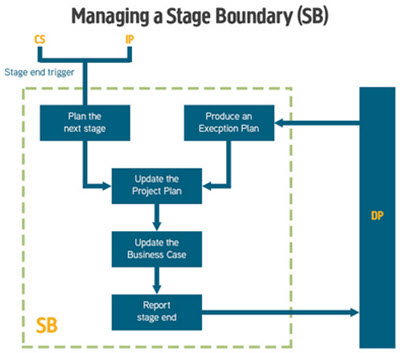Contents
One of the seven processes of PRINCE2 is Managing Stage Boundaries (MSB).
At the transition from one stage to the next in the project, it is important to make sure that the project remains on track and focused on the established goal. Also, checks must be in place to guarantee that projects that do no longer deliver business benefit are scrapped.
At every stage boundary, a an active decision must be made: is this project still viable from a business case perspective or must it be adjusted or aborted?
For a project that will continue, the next stage must be prepared.
Process management
 The process of Managing Stage Boundaries is managed by the Project Manager, who is responsible for informoring the Project Board about things such as:
The process of Managing Stage Boundaries is managed by the Project Manager, who is responsible for informoring the Project Board about things such as:
- The estimated likelyhood of the project attaining its business objective
- The project plan, especially if there has been any alterations
- Risk assesment
- Existing or potential issues
It is the Project Board the ultimately decides if the project will continue or not, but the decision will normally be fully or largely based on information and asseesments provided by the Project Manager. It is therefore of supreme importance that the Project Manager does a good job with managing stage boundaries.
Objectives of the MSB process
- Showing the Project Board that all the products in the current stage are included and defines.
- Providing the Project Board with correct and sufficient information for the board to assess if the project is still viable.
- Obtaining authorisation for the next stage.
- Obtaining margins of tolerance for the next stage.
- Record information and lessons that might be used in later stages or for other projects.
Products of the MSB process
At least eight products will be created as a part of the MSB process:
Current Plan Actuals
This represents the basis of the Project Manager’s day-to-day control of the project.
Must identify, in detail, key deliverables, resource requirements and total cost.
Any improvements from the original Stage Plan will appear in this product.
Next Stage Plan
This represents the actual information stage. When the Project Board decides if the project will be continued, and if any adjustments are required, the Next Stage Plan will be an important foundation for their decision.
Revised Project Plan
This is an up-to-date overview of the total project. Must be updated to reflect the very latest knowledge and assessments.
Must identify:
- Key deliverables
- Resource requierments
- Total cost
- Major control points within the project (e.g. stage boundaries)
Without a Revised Project Plan, it becomes difficult for the Project Board to assess progress.
Revised Business Case
The Business Case was created during the start-up phase of the project, and contains information such as:
- Reasons for doing the project
- Expected business benefits
- Expected costs
- Expected risks
At each stage boundary, we must check if the business case still matches reality or if the project has become non-viable. It is the responsability of the Project Board to monitor the ongoing viability of the project against the Business Cage.
Any changes to the Business Cage must be entered as a part of Stage Boundary Management.
Revised Project Managment Team List
List the entire management structure, including Project Board, Project Manager and any Team Managers. Project assurance roles should also be listed.
At each Stage Boundary, the list is checked, and changed if necessary, to make sure it is up to date.
Updated Risk Log
Must include:
- Identification of risks for the project
- Estimation of risks for the project
- Impact evaluation for the identified risks
- Suggested countermeasures for the identified risks
The Risk Log was created during the start-up phase of the project, and must be revised regularly to remain accurate. A stage boundary is one example of a key point where a check-up must be made, to find out if any changes should be made to reflect the current situation, knowledge and assessments.
Lessons Learned Report
This report is filled out to provide valuable information for other projects, both current and future ones. Without lessons learned reports, there is a risk of constantly “re-inventing the wheel” within the organization.
End Stage Report
The Project Manager will create an End Stage Report for the Project Board at each Stage Boundary. The report must contain the results achieved during the stage that is now ending.
